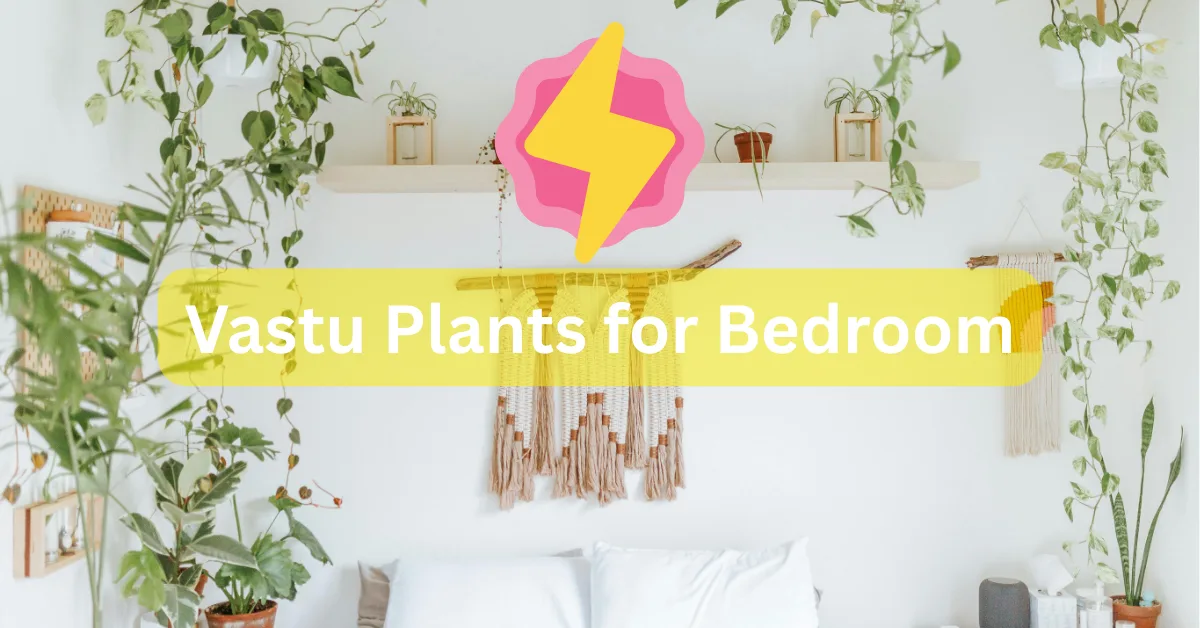Have you ever walked into a bedroom and immediately felt calm while others just made you restless without even knowing why?
According to Vastu Shastra and Feng Shui, the way you arrange your bedroom and the kinds of plants you welcome inside can seriously boost your sleep, boost oxygen level, lift your mood, and even sprinkle a little extra luck into your life.
Vastu indoor plants don’t just make your bedroom pretty but they’re also believed to bring positive vibes, balance your emotions, and create a peaceful energy flow that feels almost magical. One of the best parts of adding indoor plants in the bedroom is that many of these plants act as a natural air purifier which improves the air quality of the bedroom.
Why Plants Are Important in Bedroom Vastu?
In the hustle and bustle of modern life, our bedrooms should be more than just a place to sleep at the end of the day for relaxation, they should be our personal retreat, a space of healing energy and calmness. Vastu and Chinese Feng Shui teaches that decorating a bedroom with certain indoor plants enhances the green aesthetic, regulates positive energy and creates a nurturing environment.
Vastu Indoor plants bring the powerful Earthy tone into your space which connects you to nature’s rhythm. This connection makes your mind calm, encourages deep sleep, and promotes relaxation. Certain indoor plants like Lavender and Peace Lily are scientifically proven to promote sleeping in a space where pure oxygen flows, lower heart rate and reduces stress.
A healthy plant signifies thriving energy, while a neglected one could attract stagnation. Hence, choosing the best vastu plants for the bedroom and caring for them properly is crucial for maintaining high vibrations in your bedroom.
Whether you’re dreaming of success, good luck, seeking more relaxation, or just want your space to feel like a true sanctuary, you’re about to discover simple ways to transform your bedroom into a peaceful, nurturing haven.
Transform Your Bedroom Vibes: 10 Vastu Plants That Attract Peace, Prosperity & Pure Energy
In this guide, I’m going to share with you 10 best indoor plants to bring into your bedroom as a part of Vastu. In this post you’ll also learn how to place the bedroom plants as per Vastu Sastra for maximum good energy and good luck.
Let’s dive in.
1. Peace Lily: Symbol of Tranquility

According to Vastu Shastra, Peace Lily (Spathiphyllum) is known for its deep spiritual and energetic benefits which also promotes peace, prosperity, and positive vibrations. In Vastu Shastra, the Peace Lily is considered a symbol of harmony, purity, and tranquility.
The large, vibrant green leaves are believed to attract and circulate positive “prana” (life energy) by removing negative energies and electromagnetic radiation. In Vastu, lush green foliage of Peace Lily enhances mental calmness, emotional healing, and physical well-being.
The pristine white flowers of the Peace Lily plant encourages higher thinking and emotional balance. Its flowers promote love, compassion and unity among family members, especially between couples by nurturing a calm and soothing atmosphere inside the bedroom.
As per Vastu, the strong stems of the Peace Lily brings emotional stability and support personal growth. It helps in maintaining a good energy balance between the material and spiritual aspects of life.
How to Place Peace Lily in the Bedroom as Per Vastu Shastra?
- Place the Peace Lily in the northeast corner of the bedroom for spiritual growth and positivity.
- Do Not place the Lily plant directly on the floor. Instead Keep it on a small table or shelf.
- Do not place the Peace Lily among other indoor plants.
- Place it a little distance from the headboard to avoid excessive moisture.
How to Care Peace Lily?
- Water it once a week or when the soil feels dry.
- Provide bright, indirect sunlight. Since the direct sunlight burns the leaves and weakens the plant’s vibrational energy.
- Regularly clean the leaves with a damp cloth to remove dust.
- Set positive intentions (like gratitude, peace, or love) while watering or caring for your Peace Lily since plants are sensitive to energy and this practice boosts their vibrational effect.
- Use natural fertilizers instead of chemicals to keep the energy pure.
2. Jasmine: Enhances Romance and Sleep
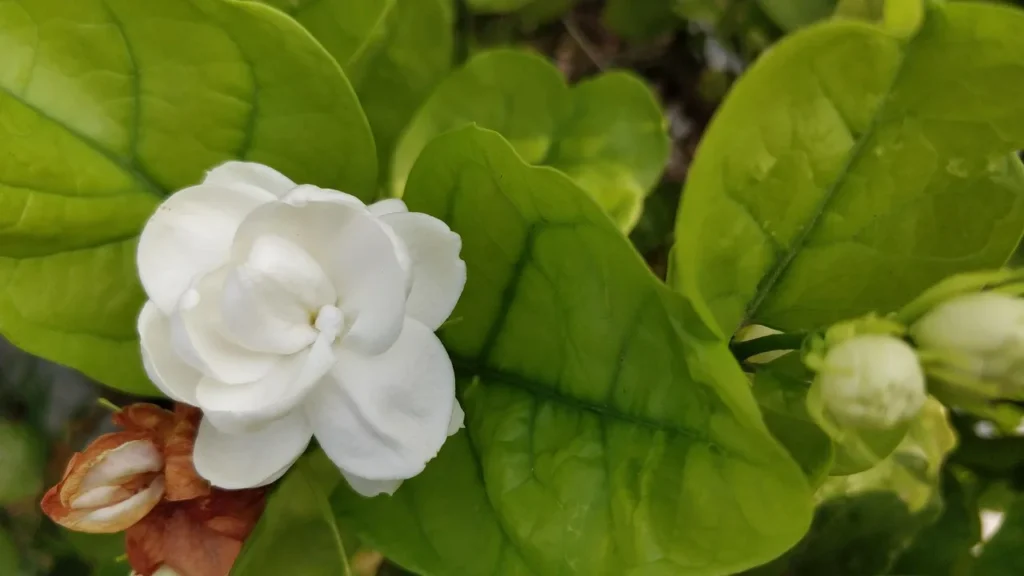
In Vastu Shastra, Jasmine is considered as a sacred indoor plant that attracts love, peace, and positivity. Its sweet fragrance brings emotional balance, reduces stress, and strengthens relationships.
In Feng Shui, Jasmine is associated with the Heart’s Cycle. It is believed to attract positive life force energy into the overall home. It enhances love, romance, emotional connection, and overall well-being.
As per Vastu, glossy deep green color leaves of Jasmine are believed to purify the environment, attract wealth & prosperity, and protect the bedroom from negative energy. In Feng Shui, green leaves represent health and renewal of positive energy.
The Star-shaped, delicate white flowers are associated with love, romance, and emotional peace among couples as per both Vastu and Feng Shui. When Jasmine flowers bloom, it spreads a sweet scent all over the bedroom.
In Feng Shui, the upward-going stems of Jasmine symbolize steady growth and progress in career, personal life, and family matters. The healthy stems are believed to help in the smooth flow of positive chi (energy) throughout the home.
How to Place Jasmine in the Bedroom As per Vastu?
- Place the Jasmine plant in the northeast or east corner of the bedroom since these directions are linked with positivity, health, and mental peace.
- Keep the Jasmine plant in a northeast or east window so that the plant can get natural light & fresh air which enhances its energy flow.
- Use a white or light pastel-colored pot to amplify its peaceful, calming vibrations.
How to Care Jasmine plant?
- Jasmine loves natural light but not direct sunlight.
- Avoid dark corners since the dark corners can lower the energy flow.
- Water the Jasmine early in the morning since watering in early hours is believed to increase their prana (life energy) in Vastu. Use filtered water or rain water for proper care.
- Wilted jasmine attracts negative energy so it is necessary to trim dead leaves/flowers immediately.
3. Lavender: The Sleep Promoter
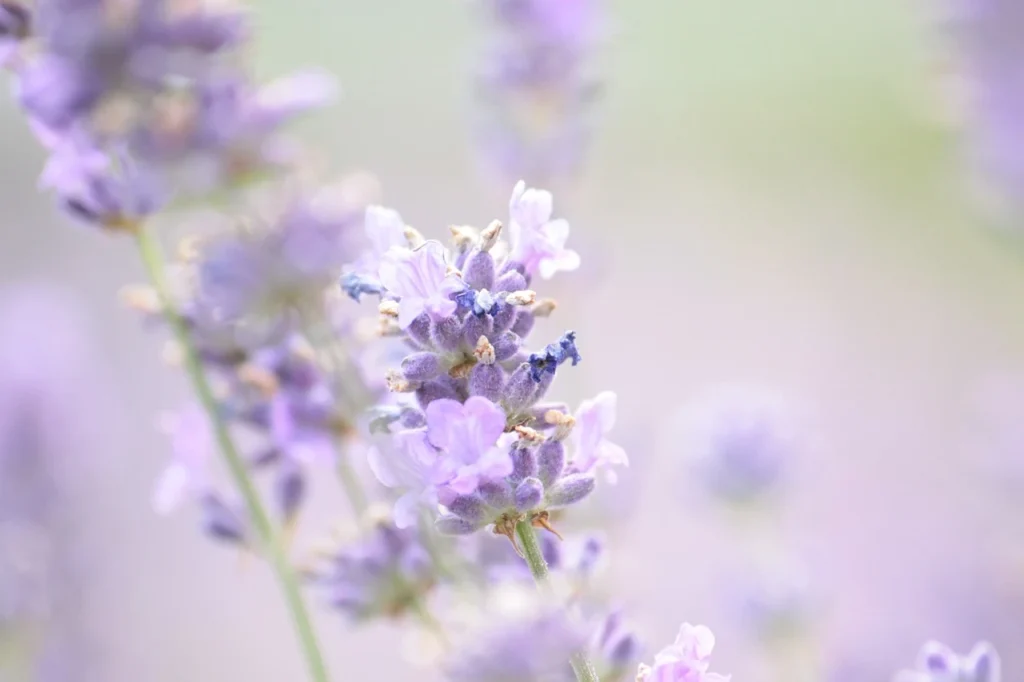
Lavender is often considered as a calming and soothing plant. Lavender helps to promote better sleep by reducing stress, anxiety and also enhances peace in the room. It helps in creating a harmonious environment where the energy flows in the right way.
The gray-green or silver-white leaves of Lavender are associated with purification and mental clarity. Its leaves help in purifying the air quality by absorbing dust & toxins from the bedroom. It also clears mental clutter, promotes healing vibrations and enhances focus & peace.
The lavender flowers are linked to peace, love, and relaxation. One of the major Vastu benefits of Lavender flower is that it emits a calming fragrance that soothes the mind and nervous system.
The lavender stems represent strength, support, and connection. Its stem symbolizes stability and resilience in personal and professional life. Stems of Lavender also help in connecting the grounding energies of the earth with the calming properties of the flowers and leaves.
How to place Lavender in bedroom as per vastu shastra?
- Place the Lavender in the North or Northeast corner of the bedroom for mental clarity, peace, and spiritual growth.
- Place it in the Northwest corner for promoting restful sleep, emotional healing, and harmony in relationships.
- Keep a potted lavender plant on the left side of your bed for emotional healing.
- Keep dried lavender flowers under or near your pillow for deep, stress-free sleep and positive dreams.
- Hang dried lavender stems on the north or northeast walls to maintain a calm and serene vibe.
How to Care Lavender Plant?
- Place Lavender Plant near a window to provide at least 4–6 hours of direct sunlight every day.
- Lavender prefers dry soil over soggy soil so water only when the top inch of soil feels dry.
- Keep windows open for some time daily if possible since Lavender needs fresh air circulation to stay healthy and energetic.
- Lightly trim the plant to remove dead flowers, stems, and leaves after blooming season to encourage new growth.
4. Aloe Vera: Natural Air Purifier
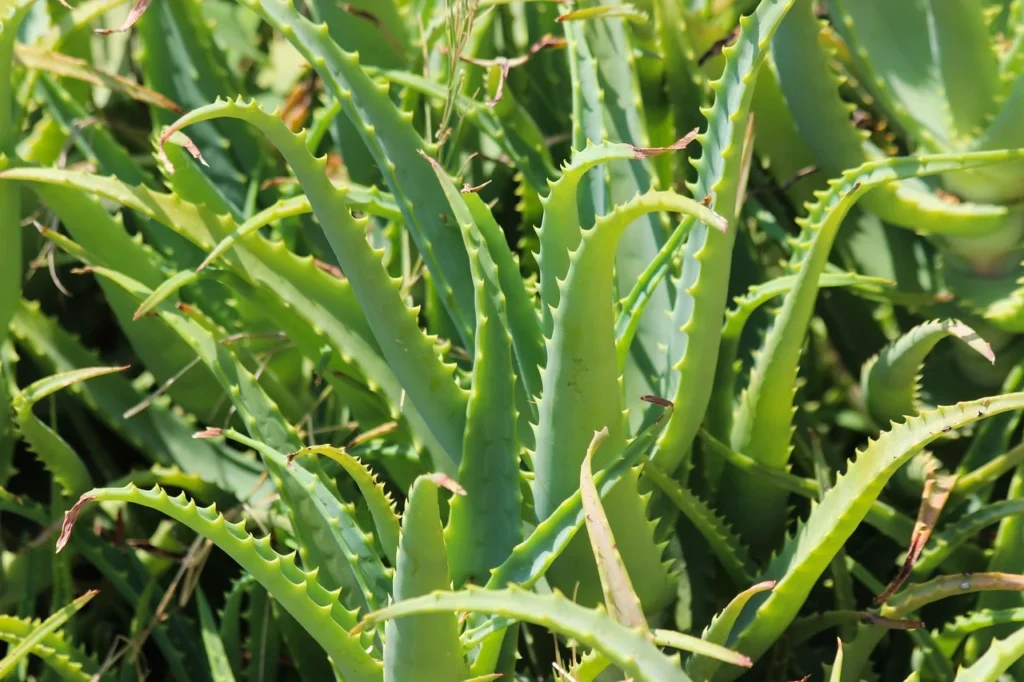
Aloe Vera is a truly powerful indoor plant for the bedroom that not only has Vastu benefits but also has health benefits. In Vastu, Aloe Vera is considered a powerful positive energy plant for bedroom that absorbs negativity and purifies the surroundings. It helps to bring prosperity when placed properly by maintaining the flow of positive vibrations.
Aloe Vera has thick, fleshy leaves filled with a clear gel. The gel inside leaves symbolizes natural healing powers and also promotes family health and emotional healing. The robust structure of the leaves acts as a powerful absorber of negative energy.
The tall, upright, bright-colored flower of Aloe Vera represents spiritual awakening, inner strength, and blessings from divine energies. As per Vastu the flower of Aloe Vera is considered as a good luck which also symbolizes financial growth and good fortune. When the Aloe Vera flower starts blooming it attracts new opportunities, success and removes the blockages from your life.
The thick, fleshy base Aloe Vera stem represents strong family bonding and resilience during hard times. The thick strong stem holds the plant’s core vitality which shields the home from instability, diseases, and external disturbances.
How to place Aloe Vera in bedroom as per Vastu Shastra?
- Place the Aloe Vera in the east direction to enhance health, vitality, and promote early morning positivity.
- Place in the north direction since it supports wealth, growth, and career opportunities while you sleep.
- Place Aloe Vera on the left side of the bed for emotional harmony.
- Do not place Aloe Vera in the South or Southwest since it can disturb sleep and bring unwanted stress.
- Never keep a dying, dried, or neglected Aloe Vera plant since it can lower the positive vibrations of the bedroom.
How to Care Aloe Vera?
- Aloe Vera loves sunlight, but too much harsh, direct sunlight can burn its leaves.
- Aloe Vera stores water in its leaves and prefers drier soil so watering once every 10–14 days is enough.
- Always use a terracotta or clay pot with a drainage hole to naturally balance energy and prevent overwatering.
- A dusty or dirty Aloe Vera can block positive energy flow so remove the dust using a soft damp cloth every week.
- Expose the Aloe Vera on full moon nights for 1–2 hours since moon energy naturally purifies and amplifies plant vibrations.
5. Lucky Bamboo Plant: Attracting Prosperity
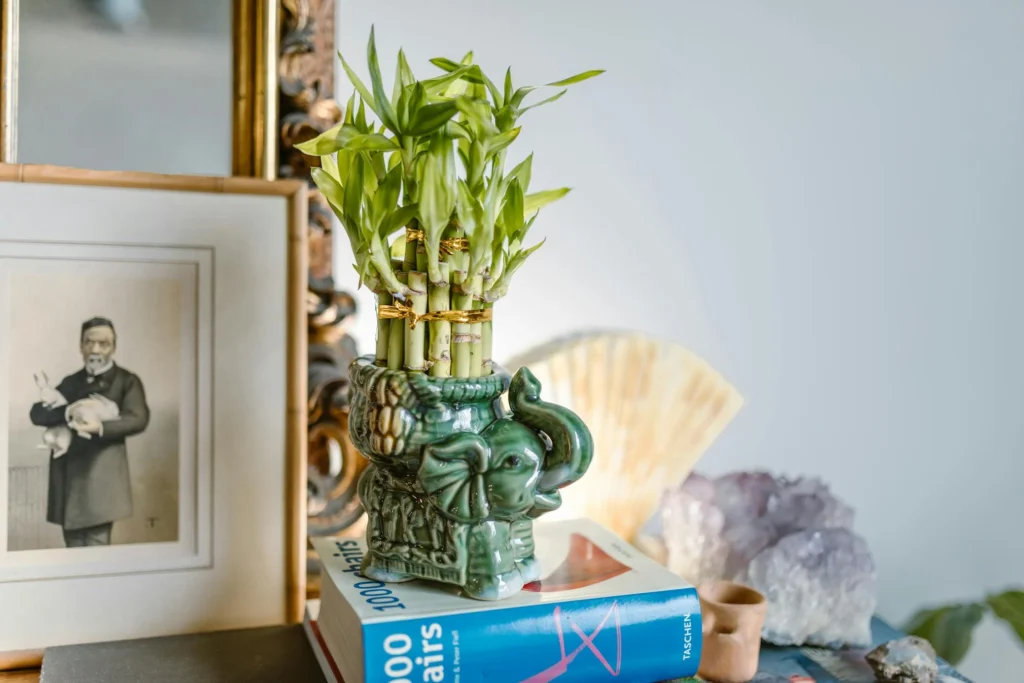
The Bamboo plant, especially the Lucky Bamboo, is highly regarded in Vastu Shastra as well as Feng Shui because it symbolizes fast personal growth, career advancement, and financial prosperity. It also carries strong positive, healing, and growth vibrations. In a bedroom, it promotes understanding, flexibility, and long-lasting love between couples.
The narrow, elongated, and sword-like leaves represent ongoing growth, hope, and energy renewal every morning. The vibrant green color of leaves calm the mind by reducing stress and anxiety.
The Upright or twisted shaped stem of Lucky bamboo symbolizes a strong foundation of good luck. Its stems encourage creative thinking, problem-solving, and resilience. Strong stems are also associated with steady income, career progression, and stable wealth.
How to place Lucky Bamboo in bedroom as per Vastu Shastra?
- Place the Lucky Bamboo in the east direction for promoting health, family harmony, and new beginnings.
- Don’t place Lucky Bamboo inside a closed cupboard or completely dark corner since it needs light to maintain good energy flow.
- Don’t place it directly in front of the bedroom door since it may block the energy rather than attracting the energy.
- Don’t place it on the floor. Always keep it elevated on a surface.
- Use 2 stalks of Lucky bamboo for love and romance, 3 stalks for happiness, 5 stalks for health, 8 stalks for wealth and 9 stalks for overall good fortune.
How to Care for Lucky Bamboo?
- Every Friday morning, gently wipe the leaves with a clean, damp cloth.
- Thank the plant mentally for bringing love, growth, and abundance in your life.
- Use a glass bowl or a ceramic pot filled with pebbles and clean water, or a natural soil pot.
- If placed in water, keep the water level just enough to cover the roots and change water every week.
- Always tie the stalks together with a red or golden ribbon.
6. Snake Plant: Purifying and Protective
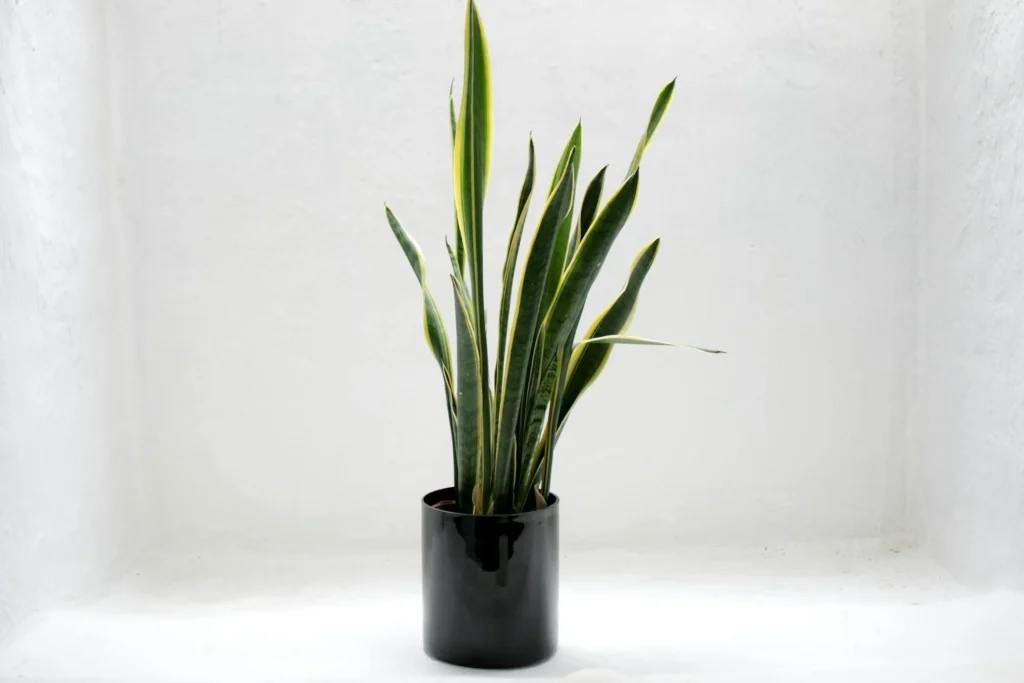
The Snake Plant, also known as Mother-in-Law’s Tongue. Snake Plant is recognized by NASA’s Clean Air Study for its ability to filter indoor air, remove toxins and ability to boost overall health, reduce allergies, and enhance concentration.
In various energy practices, the Snake Plant is believed to absorb negative energy from surroundings, create a protective shield against emotional and environmental stress and also promote positive vibes that can bring clarity, calmness, and motivation.
The long, sword-shaped, upright, and pointed snake plant leaves attract and uplift stagnant energy while promoting progress and growth. The sharp edged leaves symbolically remove negative energies and psychic disturbances.
The flowers of the snake plant can be rarely seen. Since the flower is rare, it is seen as a sign of good fortune and divine blessings. Snake plant flowers typically bloom when the plant is slightly stressed or mature. When the flower blooms, it releases a sweet and pleasant smell which also helps in air purification.
The stem of the snake plant is undergrounded which indicates steady, unseen progress and business expansion. The undergrounded stem also known as rhizome stores life energy and represents wealth conservation and emergency protection in Vastu practices.
How to Place Snake Plant in the Bedroom As per Vastu?
- Placing Snake Plant leaves near study areas or workspaces can enhance focus and decision-making.
- Placing it close to a window allows it to absorb negative energy and promote better air circulation.
- Position the plant at floor level, so the upward-growing leaves align with the rising energy of the room.
- Avoid placing it too close to the bed’s headboard; maintain some distance (at least 2–3 feet) for free flow of energy.
- Use a clay or ceramic pot since earthy materials enhance grounding energies according to Vastu.
- Don’t place it in the North-East corner of the bedroom.
How to Care Snake Plant?
- Place the plant where it gets soft, filtered sunlight ideally near an east- or southeast-facing window.
- Water only when the top 1–2 inches of soil are dry.
- Occasionally mist the plant with clean, purified water to refresh its aura.
- Choose earthy tone pots like beige, white, or light green to align with peaceful bedroom vibrations.
7. Money Plant: Wealth and Harmony
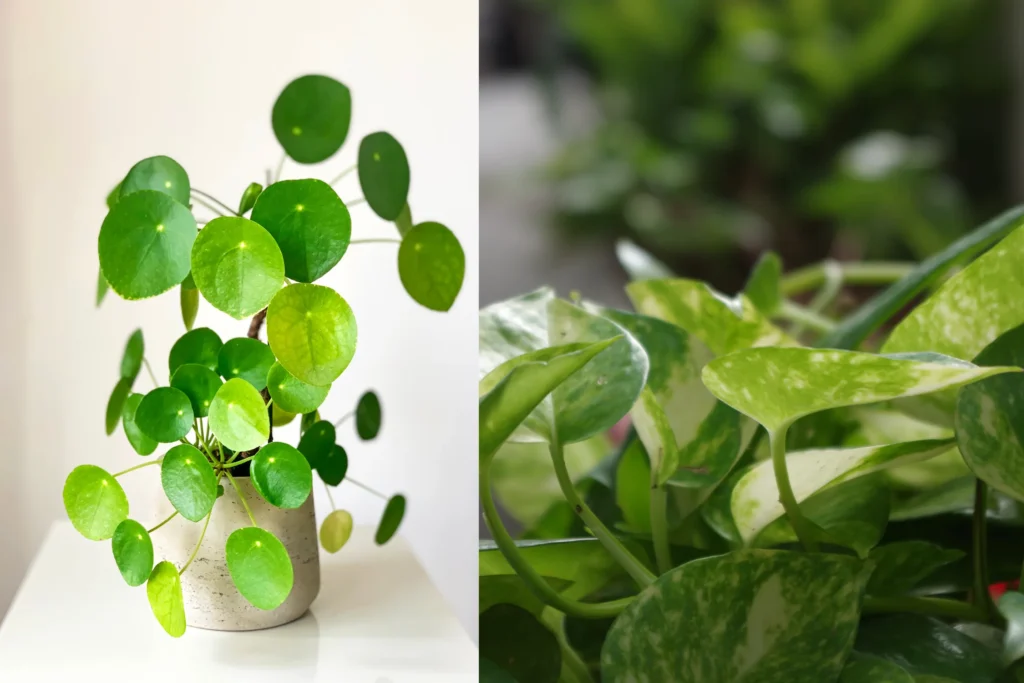
The Money Plant, also known as Devil’s Ivy or Pothos, is one of the most popular indoor plants believed to attract wealth, financial prosperity, and harmony according to Vastu Shastra. When placed correctly, it is believed to activate the flow of positive financial energy, bringing new opportunities and wealth into your life.
The green heart-shaped leaves of the money plant symbolize money, love, and financial growth. The soft, heart-shaped leaves signifies emotional bonding and harmony among family members.
The flower of the money plant rarely blooms indoors. Flower is mostly seen in outdoor or natural environments rather than in home settings. Even rare flowering represents a burst of pure, prosperous energy.
The Long, flexible, and fast-growing stem of money plant symbolizes career advancement and steady financial growth. As the stem spreads and climbs higher, it energetically attracts new opportunities and ensures continuous development in career and business.
How to Place Money Plant in Bedroom As per Vastu?
- For best Vastu results, train the Money Plant stem to climb upward using a moss stick or wall support.
- Keep the Money Plant near the southeast side of your bed, preferably on a small table.
- Use a hanging pot if space is limited. Make sure it is trailing down gracefully but not touching the floor. This helps maintain the flow of positive wealth energy.
- Use green or golden pots since placing money plants in these colors enhances the wealth vibrations.
- To strengthen relationships and personal growth, place the money plant in the south corner.
How to Care Money Plant?
- It can tolerate low light but grows faster and stronger with more light.
- Water the plant when the top 1–2 inches of soil feel dry. Avoid over watering since soggy soil can cause root rot.
- Use a balanced liquid fertilizer (like 10-10-10 NPK) at half strength.
- Prune the stems lightly to encourage bushier and healthier growth.
8. Orchids: Uplifting Love and Positivity
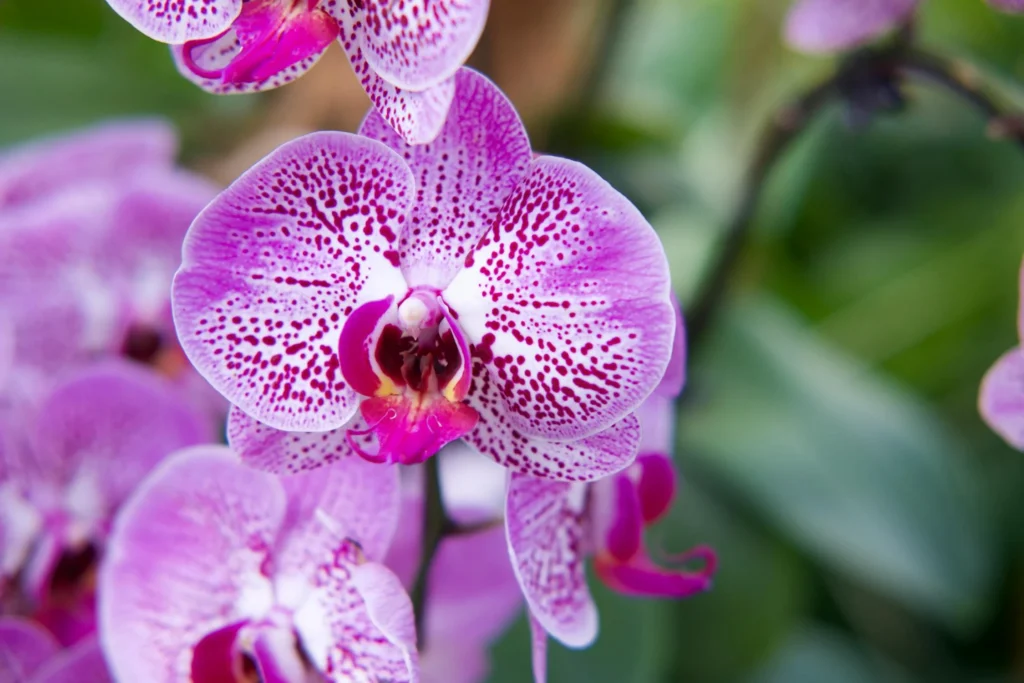
Orchids have special significance in both Vastu Shastra and Feng Shui which symbolize beauty, prosperity, fertility, love, and spiritual growth. Orchids are associated with emotional bonding and feminine energy which makes them ideal for bedrooms. Certain varieties, like purple or pink orchids can enhance wealth, good luck and career success.
Waxy, thick, and fleshy deep green color leaves help absorb stagnant or negative energy. Healthy evergreen leaves symbolizes stability and long-lasting prosperity.
The bloom cycle of Orchids flower is long-lastic often for weeks or even months which symbolizes long-term harmony in love and marriage relationships. Orchid flowers bloom in a wide range of colors like white, pink, purple, yellow, and orange. Purple and pink orchid flowers attract wealth and abundance when placed in the southeast or north direction.
The stems of Orchids have an upright structure which supports the weight of large, colorful blossoms and stores water. This upright nature of Orchid stems represents strong foundations in life. Orchid stems often store nutrients which symbolize hidden strength, patience, and resilience.
How to place Orchids in bedroom as per Vastu Shastra?
- The ideal direction of Orchids in the bedroom for love, relationship harmony, and marital bliss is SouthWest corner.
- Placing the Orchid plant in the East or Northeast wall/corner brings peace and calmness during sleep.
- Place the orchid on a bedside table, corner stand, or window sill where it can get soft, indirect sunlight.
- Avoid placing too many plants in the bedroom.
- Don’t block airflow around the orchid
How to Care Orchids?
- Keep the orchid pot clean, uncluttered, and aesthetically pleasing.
- Use Ceramic or clay pots in earth tones (beige, cream, terracotta) for Orchid. These types of pots are best for bedroom energy alignment.
- Use room-temperature water; avoid overwatering.
- Clean the leaves with a damp cloth weekly to remove dust and promote fresh airflow.
- Declutter and organize around the plant since cluttered space attracts negative energy.
9. Areca Palm: Humidity Balancer

Areca Palm is known with other various names such as Butterfly Palm, Golden Cane Palm, Yellow Palm. It has tall, feathery, arching fronds with narrow, bright green leaflets. It has Elegant, tropical look with a gentle and calming presence.
Areca Palm is a natural humidifier, it releases nearly 1 liter of water per day into the air through its leaves. The major benefit of the natural humidity is that it prevents dry skin, lips, and sinuses during dry weather.
Areca Palms have bright green, soft and non-thorny leaves which is Vastu favorable. Its leaves grow in clusters which also encourages growth, calmness, and balance of harmony. It has soft, flowing leaves which enhance the flow of positive energy in the room.
Areca Palm flowers bloom indoors only under the right conditions. When it blooms, it produces small, yellowish or cream flowers. The rare flower also benefits in Vastu Shastra, it indicates energetic purity and balance of energy.
It has thin, bamboo-like yellow-green stems which represent strength, support, and resilience in personal life and relationships. The clustered stems also signify family unity and prosperity.
How to place Areca Palm in bedroom as per Vastu Shastra?
- Place the plant on the floor in a clean ceramic, clay, or wooden pot.
- It should be positioned where it gets indirect natural light.
- Keep it away from the headboard or foot of the bed.
- Avoid overloading the space with too many plants, furniture or tables. Leave the proper space around the plant for airflow and energy movement.
- You can place a small bowl of water or pebbles nearby to promote calm and regulate energy.
- Place a single, tall Areca Palm in the East corner of the bedroom with a white or terracotta pot for maximum vastu harmony.
How to Care Areca Palm?
- Avoid direct sunlight, as it can burn the leaves and reduce positive energy flow.
- Mist the leaves lightly 2–3 times a week to maintain humidity.
- Clean leaves weekly with a soft, damp cloth to allow better photosynthesis and improve pranic flow in the room.
- Repot every 2 to 3 years if the plant becomes root-bound or growth slows down.
- Set positive intentions while watering or tending the plant.
10. Rosemary: Mind Soother
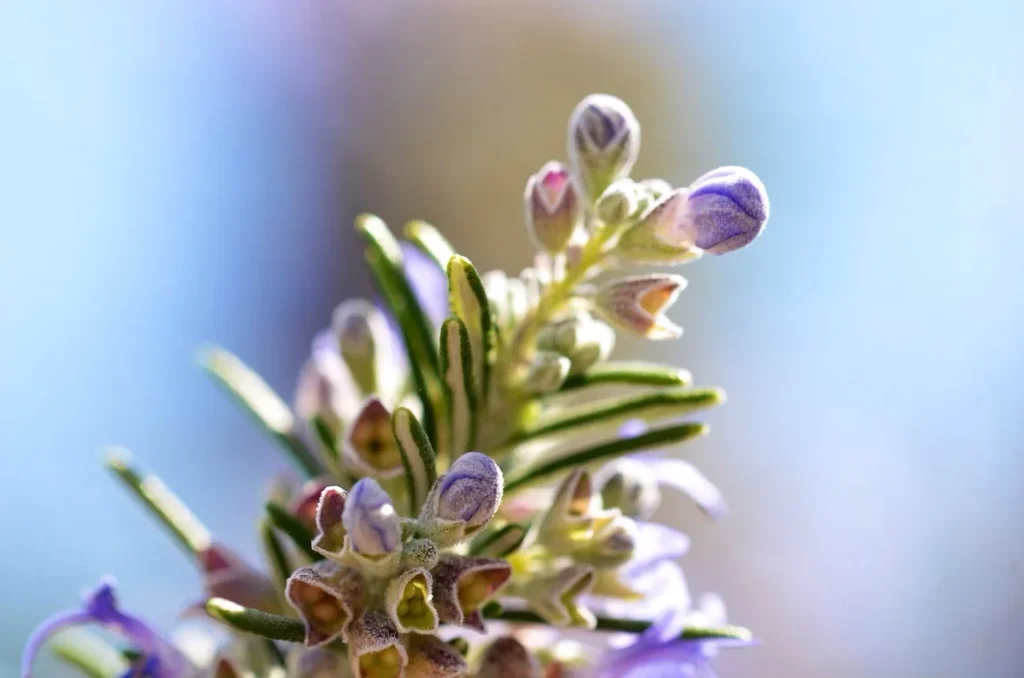
Rosemary is an aromatic evergreen herb which is considered a natural energy cleanser in both Vastu Shastra and folk traditions. Rosemary plant is believed to remove unwanted energies, emotional heaviness, and lingering spiritual negativity from a space. Its sharp fragrance stimulates the mind, clears mental fog, and uplifts stagnant energy.
Thin, needle-like Rosemary leaves help in air purification by protective and uplifting energy. Its leaves also help in sharpening the mind, memory and making focus on study especially when placed on reading nook.
Rosemary flowers bloom in clusters during spring and summer. In Vastu, Small, tubular, two-lipped flowers are known as symbols of purity, healing, and devotion. Rosemary flower is rare but considered highly auspicious in Vastu.
Woody, upright, and branching stems represent stability, protection, and rootedness. Rosemary stems have a grounding structure. This grounding structure helps in balancing excessive air or emotional imbalance.
How to place Rosemary in bedroom as per Vastu Shastra?
- Place a rosemary plant in a white or terracotta pot in the East corner of your room for clarity and vitality.
- Place a rosemary in the Southeast direction to activate stagnant zones, prevent & protect from negativity, uplifts mood.
- Keep 1 Rosemary plant. Don’t cluster with too many strong-scented herbs
How to care Rosemary?
- Avoid plastic pots. Use earthen, white, or green pots for the Rosemary plant.
- Place the plant on a window sill, side table, or shelf where it receives indirect sunlight.
- Keep in a space with natural ventilation or near an open window.
- Lightly trim the tops every 2–3 weeks to encourage bushy, vibrant growth.
- Speak a positive affirmation while watering, like: “You protect and energize my space. Thank you.”
- Apply organic compost tea or herbal fertilizer once every 4–6 weeks during the growing season.
Final Thoughts: Choosing the Best Vastu Plants for Your Bedroom
Integrating Vastu-friendly plants into your bedroom brings powerful energy shifts, improves indoor air quality, removes negative energy, and boosts mental clarity & calmness. Choose plants based on your specific needs.
If you want peace and calmness then you should go with Areca or Orchids. For protecting your bedroom against negative energy and boost positivity, go with Snake Plant. To enhance the relationship among couples with love, romance, harmony and emotional peace, you should add Jasmine or Lavender indoor plants for the bedroom.
Bring balance, beauty, and positive energy into your bedroom with Vastu-aligned indoor plants. Start today by choosing the right Vastu plant for your bedroom.
Frequently Asked Questions (FAQs):
Which plant is best for bedroom as per Vastu?
According to Vastu Shastra, Jasmine, Money Plant, Lucky Bamboo, Lavender and Snake Plant are suitable for bedroom. These indoor plants are believed to bring good luck, remove negative energy, purify air and create a peaceful environment. These vastu plants are also associated with love, romance, and emotional peace among couples.
Can indoor plants really promote better sleep?
Indoor plants like Jasmine, Lavender, Aloe Vera, Orchid are the best plants for bedroom to promote better sleep. These vastu plants helps to promote better sleep by reducing stress, anxiety and also enhances peace in the room.
Is Snake Plant good for bedroom Vastu?
Snake plant is scientifically proved indoor plant which is believed to absorb negative energy. As per Vastu, the Snake plant flower is recognized as a sign of good fortune and divine blessings. Placing Snake Plant near a window helps to absorb negative energy and promote better air circulation.

Hello there, my name is Anil Pun Magar and I am founder of this blog (MinimalAura). I have 5 years of working experience in home decoration field. As the founder of MinimalAura, I am sharing insights on modern minimalist living, home organization, and aesthetic interior design. My aim is to inspire a lifestyle that blends functionality with beauty.

